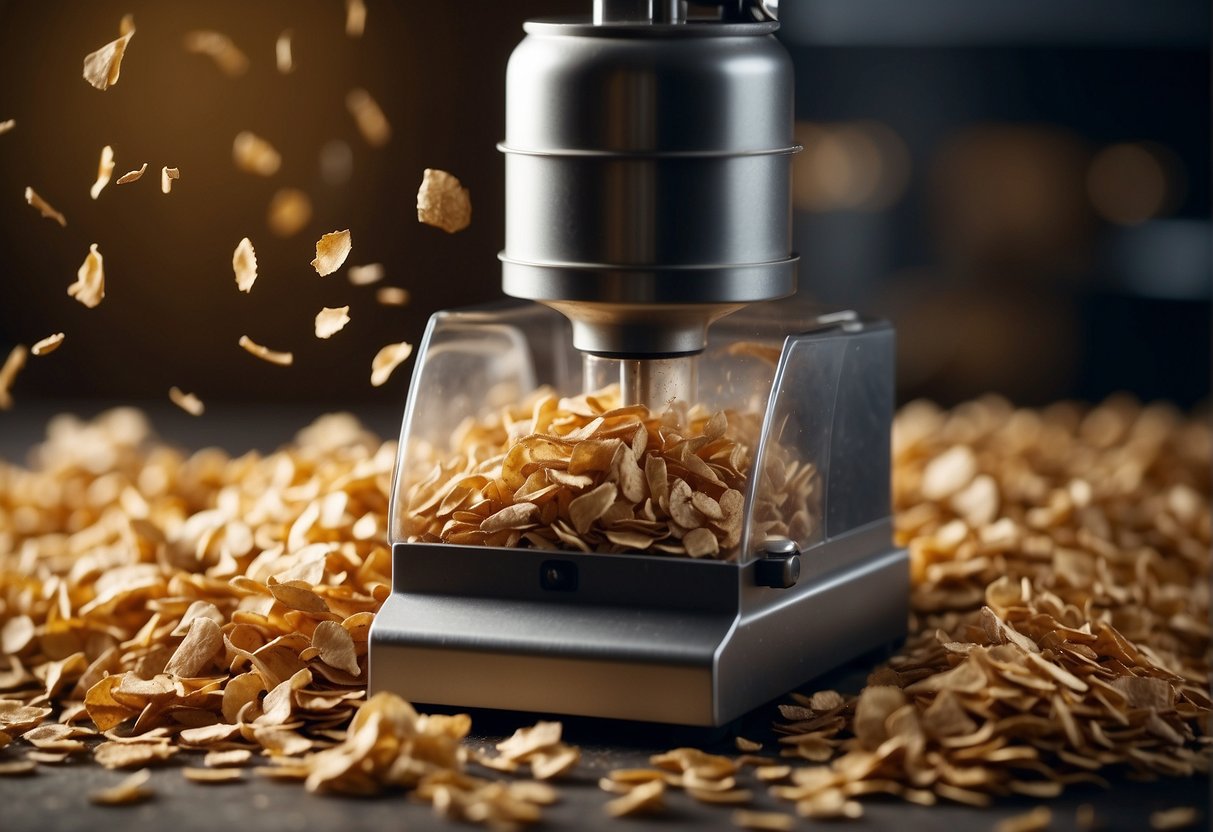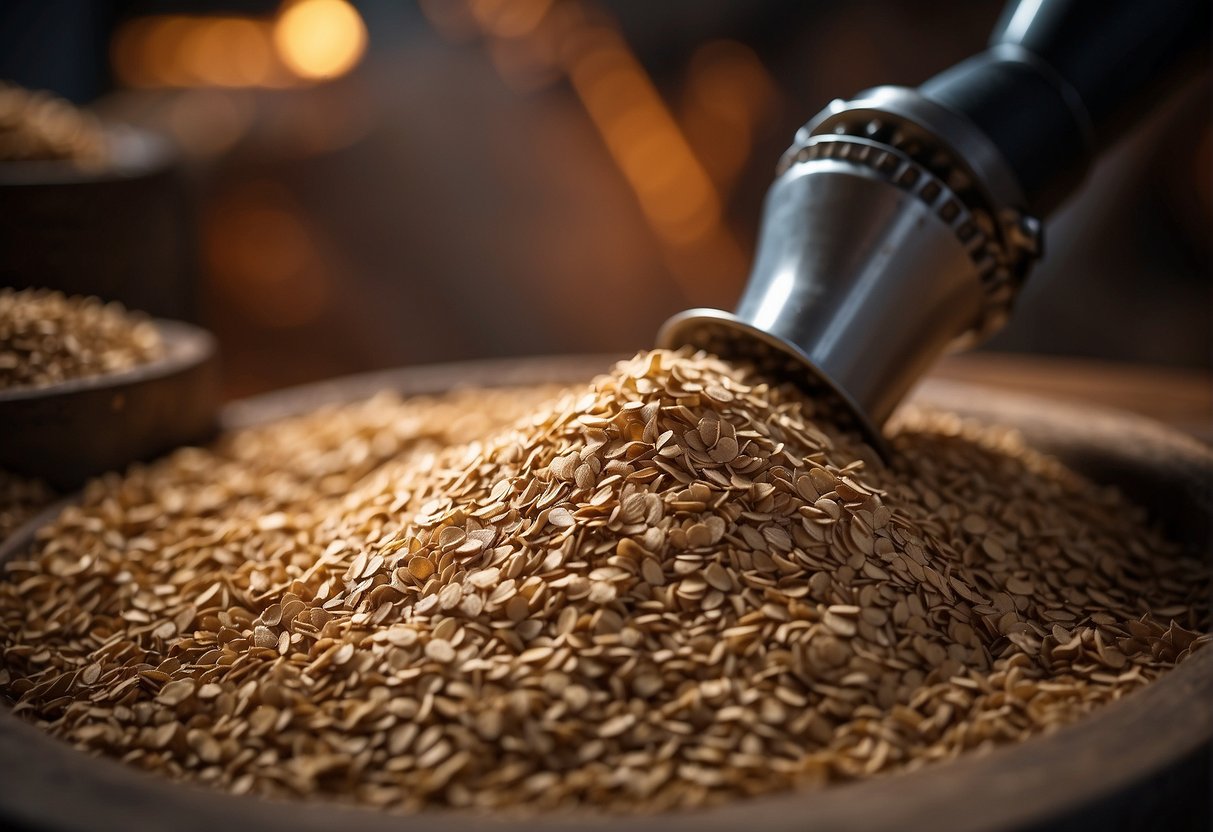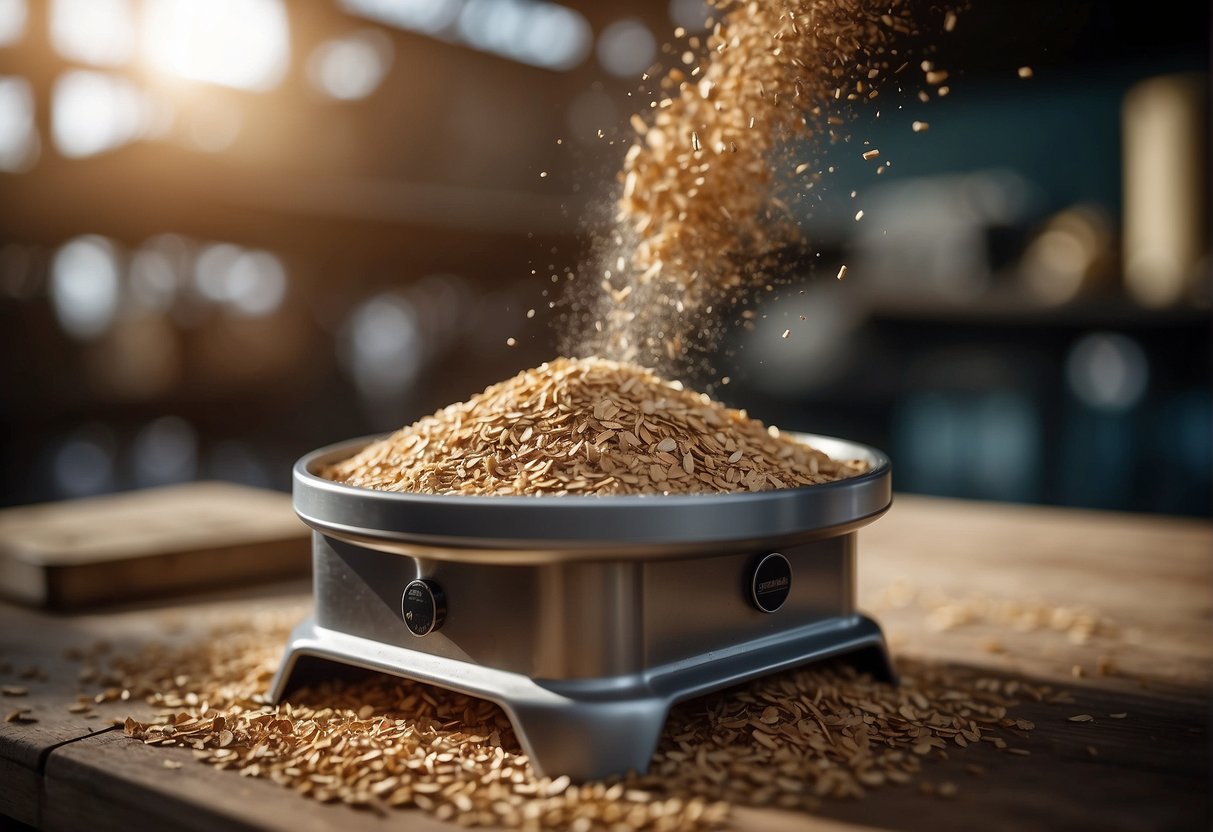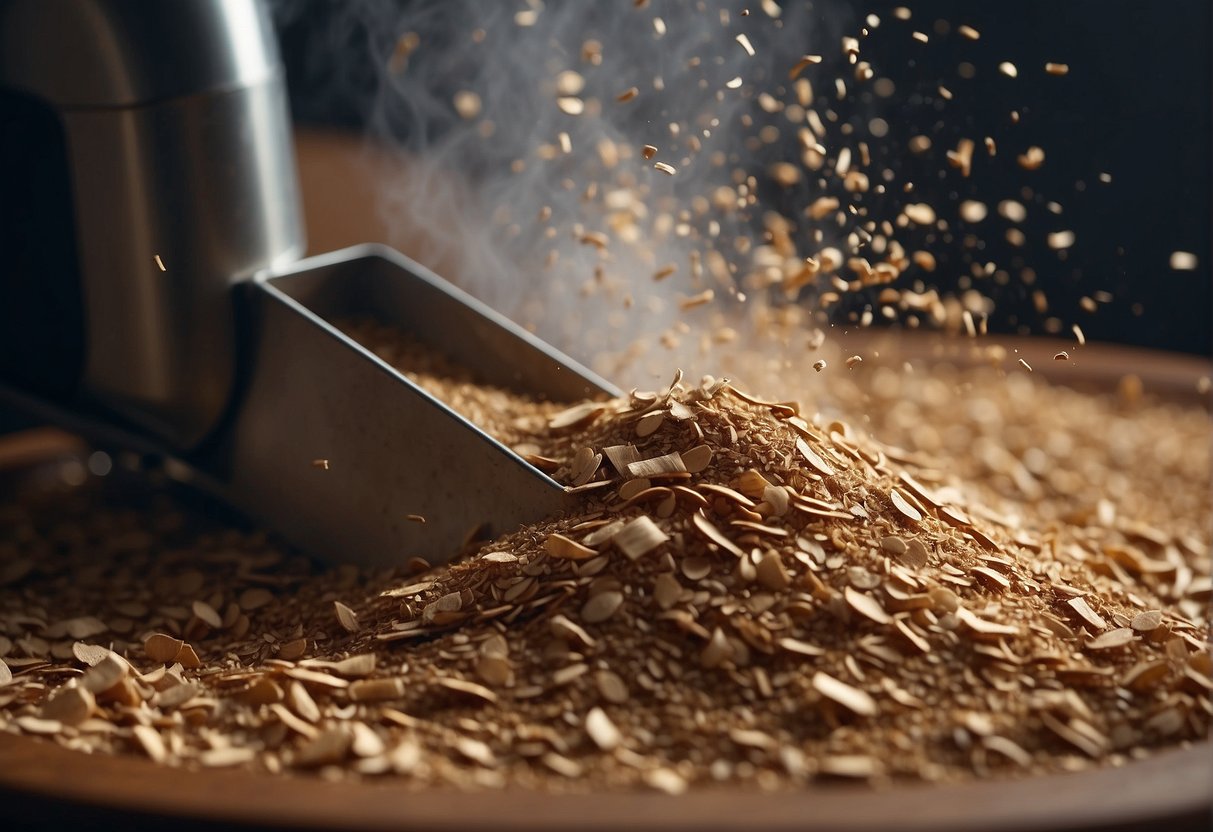Grinding wood chips into powder is a useful technique that can be used for various purposes, from creating homemade incense to producing sawdust for smoking meat. However, the process can be challenging, especially if you’re new to it. In this article, I will share with you some simple steps on how to grind wood chips into powder effectively.
Before we dive into the details, let’s first understand what wood chips are and their uses. Wood chips are small pieces of wood that are commonly used for landscaping, animal bedding, and smoking meat. They come in different sizes and shapes, and their texture can vary depending on the type of wood. Knowing the type of wood chips you’re working with is crucial as it can affect the grinding process and the final product.
Now that we have a basic understanding of wood chips let’s move on to the preparation process. Proper preparation is essential to ensure a smooth grinding process and to prevent any accidents. We will discuss the necessary equipment and safety measures in the following sections.
Key Takeaways
- Understanding the type of wood chips you’re working with is crucial to the grinding process.
- Proper preparation is essential to ensure a smooth grinding process and to prevent accidents.
- The grinding process can be optimized by choosing the right equipment and machinery.
Understanding Wood Chips and Their Uses
As someone who frequently grinds wood chips into powder, it’s important to understand the different types of wood chips and their uses. Here are some of the most commonly used types of wood chips and their applications:
Types of Wood for Chips
-
Oak: Oak wood chips are known for their strong, smoky flavor and are commonly used in smoking meats and cheeses.
-
Pine: Pine wood chips are milder in flavor and are often used for smoking poultry and fish.
-
Pecan: Pecan wood chips have a sweet, nutty flavor and are ideal for smoking pork and beef.
-
Hickory: Hickory wood chips have a strong, bacon-like flavor and are commonly used for smoking ribs and brisket.
-
Mesquite: Mesquite wood chips have a distinct, earthy flavor and are ideal for smoking beef, lamb, and vegetables.
-
Apple and Pear: Fruitwood chips such as apple and pear are mild in flavor and are often used for smoking poultry, pork, and fish.
Applications in Smoking and Cooking
Wood chips are commonly used in smoking and cooking to add flavor to meats, cheeses, and vegetables. By soaking the wood chips in water before use, they will release smoke when heated, infusing the food with a delicious smoky flavor.
Wood Chips for Biofuel and Animal Feed
In addition to their culinary uses, wood chips are also used as a source of biofuel and animal feed. Wood chips can be burned to generate heat and electricity, or they can be used as a source of fiber for animal feed.
Overall, understanding the different types of wood chips and their uses is essential for anyone who frequently grinds wood chips into powder. By selecting the right type of wood chip for your needs, you can ensure that your finished product has the desired flavor and aroma.
Preparation of Wood Chips for Grinding
As a woodworker, I often find myself needing to grind wood chips into a fine powder. Whether it’s for making wood filler or adding wood chips to compost, there are several steps that need to be taken to ensure the wood chips are ready for grinding.
Drying Process
The first step in preparing wood chips for grinding is to dry them. Moisture in the wood chips can cause the grinding process to be less efficient, and can also lead to mold growth. To dry the wood chips, I typically spread them out in a single layer on a flat surface, such as a tarp or concrete slab. I then leave them to dry in the sun for a few days, turning them occasionally to ensure they dry evenly.
Size Reduction Techniques
Once the wood chips are dry, the next step is to reduce their size. There are several size reduction techniques that can be used, including using a wood chipper or sawdust machine. A wood chipper is a machine that can be used to break down larger pieces of wood into smaller chips. Sawdust machines, on the other hand, are designed to turn wood chips into sawdust. The choice of machine will depend on the raw material available and the desired wood particle size.
When using a wood chipper, it’s important to ensure that the wood chips are the right size for the machine. If the wood chips are too large, they can damage the machine or cause it to become clogged. If the wood chips are too small, they may not be suitable for grinding.
In conclusion, preparing wood chips for grinding requires careful consideration of the drying process and size reduction techniques. By following these steps, woodworkers can ensure that their wood chips are ready for grinding into a fine powder.
Grinding Equipment and Machinery
As someone who has experience grinding wood chips into powder, I can tell you that choosing the right machinery is crucial to achieving the desired results. In this section, I will discuss the various types of equipment you can use for grinding wood chips into powder, as well as their advantages and disadvantages.
Choosing the Right Machinery
There are several types of machinery that you can use to grind wood chips into powder. The most common ones include hammer mills, blenders, and food processors.
Hammer mills are the most popular choice for grinding wood chips into powder. They are cost-effective and can handle large volumes of wood chips at once. However, they require regular maintenance to keep them in good working order.
Blenders and food processors are also good options for grinding wood chips into powder. They are easy to use and require little maintenance. However, they may not be as powerful as hammer mills, which can impact the quality of the final product.
When choosing machinery for grinding wood chips into powder, it is important to consider factors such as the motor, voltage, and capacity. You should also consider the cost of the machinery, as well as the cost of maintenance and repairs.
Maintenance and Safety
Regardless of the type of machinery you choose, it is important to perform regular maintenance to keep it in good working order. This includes cleaning the machinery after each use, checking for wear and tear, and replacing any damaged parts.
It is also important to follow safety guidelines when using machinery for grinding wood chips into powder. This includes wearing protective gloves and safety goggles to protect yourself from flying debris. You should also ensure that the machinery is properly grounded to prevent electrical shocks.
In conclusion, choosing the right machinery and performing regular maintenance are key to grinding wood chips into powder. By following these guidelines, you can ensure that your machinery is safe and effective, and that you achieve the desired results.
Grinding Process and Optimization
Grinding wood chips into powder requires a careful and optimized process to achieve the desired particle size and consistency. In this section, I will discuss the key aspects of the grinding process and how to optimize it for best results.
Grinding Mechanisms and Techniques
Wood breakage mechanisms and size reduction techniques play a crucial role in the grinding process. The most common grinding techniques used for wood chips include hammer mills, knife mills, and attrition mills. These machines use different mechanisms to break down the wood chips into smaller particles. Hammer mills use high-speed rotating hammers to break down the chips, while knife mills use sharp blades to cut the chips. Attrition mills use a combination of impact and rubbing to break down the chips.
Controlling Particle Size
Controlling the particle size of the ground wood chips is critical for achieving the desired consistency and quality of the final product. The particle size can be controlled by adjusting the sieve or mesh size of the grinding machine. A smaller mesh size will produce finer particles, while a larger mesh size will produce coarser particles. It is important to note that the particle size distribution can also affect the flowability and packing density of the powder.
Energy Consumption and Efficiency
Energy consumption and efficiency are important factors to consider when grinding wood chips into powder. Specific energy consumption (SEC) is a measure of the energy required to grind a unit of mass of the material. It is important to optimize the grinding process to minimize the SEC while achieving the desired particle size and consistency. Dust collectors can also be used to minimize the amount of dust generated during the grinding process, which can improve efficiency and reduce the risk of health hazards.
In summary, the grinding process for wood chips requires careful consideration of the grinding mechanisms, particle size control, and energy consumption. By optimizing these factors, one can achieve the desired particle size and consistency while minimizing energy consumption and dust generation.
Storing and Using Ground Wood Chips
After grinding wood chips into powder, it’s important to store them properly to ensure their quality and usability. Here are some airtight storage solutions for ground wood chips:
Airtight Storage Solutions
-
Mason jars: These are great for small batches of ground wood chips. They’re airtight, reusable, and easy to label.
-
Ziplock bags: These are good for larger batches of ground wood chips. Make sure to squeeze out as much air as possible before sealing the bag.
-
Plastic containers with tight-fitting lids: These are ideal for storing larger amounts of ground wood chips. Look for containers that are made from food-grade plastic and have airtight seals.
Once you’ve stored your ground wood chips, you can use them in a variety of ways. Here are some ideas:
Using Ground Wood Chips in Gardens and Grills
-
Compost: Ground wood chips are a great addition to compost. They’re rich in carbon, which helps balance the nitrogen-rich materials in your compost pile. Just make sure to mix them in well with the other materials.
-
Soil amendment: You can also use ground wood chips as a soil amendment. They’ll help improve soil structure and drainage, and they’ll also add organic matter to the soil.
-
Mulch: Ground wood chips make a great mulch for your garden. They’ll help retain moisture in the soil, suppress weeds, and regulate soil temperature.
-
Smoking and grilling: Ground wood chips can be used in smokers and grills to add flavor to your food. Just make sure to soak them in water for at least 30 minutes before using them.
Using ground wood chips is a sustainable and cheaper alternative to buying commercial products. By grinding your own wood chips, you can repurpose waste material and reduce your carbon footprint.
Frequently Asked Questions
What manual methods are available for grinding wood chips into powder?
Manual methods for grinding wood chips into powder include using a mortar and pestle, a hand-held grinder, or a food processor. While these methods are effective, they can be time-consuming and require a lot of effort.
Can wood chips be ground into powder using household tools?
Yes, wood chips can be ground into powder using household tools such as a blender or coffee grinder. However, these tools may not be powerful enough to grind the wood chips efficiently. It is recommended to use heavy-duty grinders for efficient chip breaking.
What is a hammer mill and how does it work for making wood powder?
A hammer mill is a machine used to shred or crush materials into smaller pieces. It works by repeatedly hitting the material with a series of hammers until it is small enough to pass through a screen. Hammer mills are commonly used in the production of wood powder as they can quickly and efficiently reduce the size of wood chips.
How effective is a ball mill in producing fine wood powder?
A ball mill is a type of grinder used to grind materials into fine powder. While it can be used for making wood powder, it is not the most efficient method. Ball mills require a lot of energy to operate and may not produce a consistent, fine powder.
What are the steps involved in making wood powder at home?
The steps involved in making wood powder at home include gathering the necessary tools such as a heavy-duty grinder, placing the wood chips into the grinder’s hopper or chamber, and grinding the wood chips into a fine powder. It is important to wear protective gloves and safety goggles to protect yourself from flying debris.
Which type of grinder is most efficient for converting wood chips into sawdust?
A hammer mill is the most efficient type of grinder for converting wood chips into sawdust. It is designed to break down the tough, fibrous structure of wood chips into smaller particles, making it easier to process and use.

Hi, I’m Sal Muller of Tooltrip.com. My DIY experience led me to understand essential power tools for home projects. Tooltrip.com guides enthusiasts and professionals in choosing right tools for any job. I provide concise top tool reviews for easier, efficient DIY.





